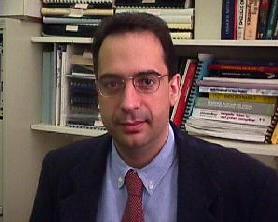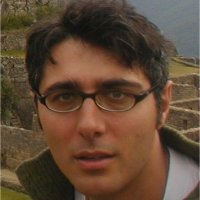2013 Multi-modal Gesture Recognition Workshop ICMI
Program Committee

Richard Bowden
University of Surrey, Guildford, United Kingdom
r.bowden@surrey.ac.uk
Richard Bowden received a BSc in computer science from the University of London in ’93, an MSc with distinction from the University of Leeds in ’95, and a PhD in computer vision from Brunel University in ’99 for which he was awarded the Sullivan Doctoral Thesis Prize. He is Professor of Computer Vision and Machine Learning at the University of Surrey, UK, where he leads the Cognitive Vision Group within the Centre for Vision Speech and Signal Processing and was recently awarded a Royal Society Leverhulme Trust Senior Research Fellowship. His research centres on the use of computer vision to locate, track, and understand humans. He is an Associate Editor for Image and Vision Computing and IEEE Pattern Analysis and Machine Intelligence. He was a member of the British Machine Vision Association (BMVA) executive committee and a company director for seven years. He is a member of the BMVA, a fellow of the Higher Education Academy, and a senior member of the IEEE.

Carol Neidle
Boston University, Boston, United States of America
carol@bu.edu
Professor Neidle teaches courses in general linguistics and French linguistics. Her research interests include syntactic theory and the syntactic structure of American Sign Language (ASL). Professor Neidle is the Director of the American Sign Language Linguistic Research Project (ASLLRP). Funding from the NSF supports linguistic research on the syntactic structure of ASL, development of computational tools (including SignStream, a MacOS application) to facilitate analysis of signed language and gesture, and collaborative research with computer scientists interested in the problem of sign language recognition. Through our National Center for Sign Language and Gesture Resources, several different types of experimental resources and analyzed data are made publicly available. Her publications include The Syntax of American Sign Language: Functional Categories and Hierarchical Structure (MIT Press) and The Role of Case in Russian Syntax (Dordrecht: Kluwer).

Dimitris Metaxas
Rutgers, City of New Brunswick, United States of America
dnm@cs.rutgers.edu
Dr. Dimitris Metaxas is a Distinguished Professor in the Department of Computer Science at Rutgers University since July 2007. From September 2001 to June 2007 he was a Professor in the same department. He is currently directing the Center for Computational Biomedicine, Imaging and Modeling (CBIM). From January 1998 to September 2001 he was a tenured Associate Professor in the Computer and Information Science Department of the University of Pennsylvania and Director of the VAST Lab. Prior to this he was an Assistant Professor in the same department since 1992. Prof. Metaxas received a Diploma in Electrical Engineering from the National Technical University of Athens of Athens Greece in 1986, an M.Sc. in Computer Science from the University of Maryland, College Park in 1988, and a Ph.D. in Computer Science from the University of Toronto, Ontario, Canada in 1992. Dr. Metaxas has been conducting research towards the development of formal methods upon which both computer vision, computer graphics and medical imaging can advance synergistically. In computer vision, he works on the simultaneous segmentation and fitting of complex objects, shape representation, statistical model-based tracking, learning, sparsity, ASL and gesture recognition. In particular he is focusing on human body and shape motion analysis, human surveillance, security applications, ASL recognition, behavior modeling and analysis and scalable solutions to large and distributed sensor-based networks.

Fernando De la Torre
Carnegie Mellon University, Pittsburgh, United States of America
ftorre@cs.cmu.edu
Fernando De la Torre received his B.Sc. degree in Telecommunications, as well as his M.Sc. and Ph. D degrees in Electronic Engineering from La Salle School of Engineering at Ramon Llull University, Barcelona, Spain in 1994, 1996, and 2002, respectively. In 1997 and 2000, he became Assistant and Associate Professor in the Department of Communications and Signal Theory in Enginyeria La Salle. In 2003 he joined the Robotics Institute at Carnegie Mellon University and currently he is Research Associate Professor. His research interests are in the fields of Computer Vision and Machine Learning. Currently, he is directing the Human Sensing Laboratory.

Sergio Escalera
Computer Vision Center (UAB) and University of Barcelona, Spain
sergio.escalera.guerrero@gmail.com
Sergio Escalera is Full Professor at the Department of Mathematics and Informatics, Universitat de Barcelona, where he is the head of the Informatics degree. He is ICREA Academia. He leads the Human Pose Recovery and Behavior Analysis Group. He is Distinguished Professor at Aalborg University. He is vice-president of ChaLearn Challenges in Machine Learning, leading ChaLearn Looking at People events. He is also Fellow of the ELLIS European Laboratory for Learning and Intelligent Systems working within the Human-centric Machine Learning program. He participated in several international funded projects and received an Amazon Research Award. He has published more than 300 research papers and received a CVPR best paper award nominee and a CVPR outstanding reviewer award.

Thomas B. Moeslund
Aalborg University, Aalborg, Denmark
tbm@create.aau.dk

Stan Sclaroff
Boston University, Boston, United States of America
sclaroff@bu.edu
Stan Sclaroff joined the BU Department of Computer Science in 1995 after completing his PhD at MIT. He founded the Image and Video Computing research group at Boston University in 1995. He served as the Chair of the Department from 2007-2013. Stan’s research interests are in computer vision, pattern recognition, and machine learning. Stan is an expert in the areas of tracking, video-based analysis of human motion and gesture, deformable shape matching and recognition, as well as image/video database indexing, retrieval, and data mining methods. He developed one of the first content-based image retrieval systems for the Internet, the ImageRover, years before Google Image Search appeared. His more recent work has focused on human tracking algorithms, analysis and identification of hand motion related to sign language, and filtering methods for multimedia retrieval.

Xavier Baró
Universitat Oberta de Catalunya, Barcelona, Catalonia
xbaro@uoc.edu
Xavier Baró received his B.S. degree in Computer Science at the Universitat Autònoma de Barcelona (UAB) in 2003. In 2005 he obtained his M.S. degree in Computer Science at UAB, and in 2009 the Ph.D degree in Computer Engineering. At the present he is a lecturer and researcher at the IT, Multimedia and Telecommunications department at Universitat Oberta de Catalunya (UOC). He is involved on the teaching activities of the Computer Science, Telecommunication and Multimedia degrees of the UOC, and collaborates as assistant professor on the teaching activities of the Computer Science degree at the Applied Mathematics and Analysis of the Universitat de Barcelona (UB). In addition, he is involved on the Interuniversity master on Artificial Intelligence (UPCUBURV). He is cofounder of the Scene Understanding and Artificial Intelligence (SUNAI) group of the UOC, and collaborates with the Computer Vision Center of the UAB, as member of the Human Pose Recovery and Behavior Analysis (HUPBA) group. His research interests are related to machine learning, evolutionary computation, and statistical pattern recognition, specially their applications to generic object recognition over huge cardinality image databases.

Jordi Gonzàlez
Computer Vision Center and Universitat Autònoma de Barcelona, Barcelona, Spain
jordi.gonzalez@uab.cat
Dr. Jordi Gonzàlez received the Ph.D. degree in Computer Engineering in 2004 from Universitat Autònoma de Barcelona (UAB), Catalonia. He was a postdoctoral fellow at the Institut de Robòtica i Informàtica Industrial (IRI), a Joint Research Center of the Technical University of Catalonia (UPC) and the Spanish Council for Scientific Research (CSIC). At present, he is Associate Professor in Computer Science at the Computer Science Department, UAB. He is also a research fellow at the Computer Vision Center, where he has co-founded 2 spin-offs and the Image Sequence Evaluation (ISE Lab) research group in 2004. His research interests lie on pattern recognition and machine learning techniques for the computational interpretation of human behaviours in image sequences, or Video Hermeneutics. He has co-organized the THEMIS (BMVC2008 and ICCV2009), ARTEMIS (ACM MM2010, ECCV2012 and ACM MM2013) and ChaLearn LAP (ICMI2013, ECCV2014 and CVPR2015) workshops related to the video-based analys is of human motion in surveillance, films and social media footage. He has served as Area Chair (ICPR2012 and ICIAP2015); Publicity Chair at AVSS2012; Workshop Chair (ICCV2011 and AVSS2015); Local Arrangement Chair at ICCV2011; and Tutorial Chair at ibPRIA2011. He has co-organized Special Issues in IJPRAI (2009), CVIU (2012), MVA (2013) and TPAMI (2015) journals. He is member of the Editorial Board of CVIU and IET-CVI journals. He is also member of IEEE, Spanish Association on Pattern Recognition (AERFAI) and Catalan Association for Artificial Intelligence (ACIA).
News
There are no news registered in